
Meeting report
Supramolecular chemists assemble in Warsaw
Supramolecular Chemists and Crystallographers continue to produce remarkably versatile, complex, self assembling molecules, many of which are elaborate multicomponant systems of organic molecules stitched together with cations. The structure included inventively tailored channels, frames, pillared chambers, and multistoried rabbit warrens. Representatives from most of the leading laboratory in the world were gathered in Warsaw, Poland in July 1998 to discuss the latest supramolecular structures. The meeting was organized by Janusz Lipkowski and Kinga Suwinska, Jean-Marie Lehn (France), Nobel Laureate and pioneer in the field was the Honorary Chairman of the International Scientific Committee.
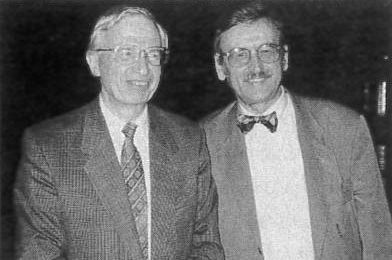 Virtual and virtuous meeting chairs, Lehn and Lipkowski.
Virtual and virtuous meeting chairs, Lehn and Lipkowski.
In a brilliant opening lecture combining elegant chemistry and a conceptional overview, Lehn contrasted molecular and supramolecular nano structures. He said that the principal difference between them is that in the molecular approach the molecules are synthesized with preorganized strategies in a traditional way, while supramolecular structures are self-assembled arrays that are spontaneously generated. Lehn's work demonstrates the presence of a great deal of fore thought in directing how molecules interact in the self assembly process. He stresses the reversibility, diversity and "healing" process of his systems. The same building blocks can be induced to rearrange under certain conditions. By combining anions with fixed association sites and cations that favor types of coordination (octahedral, tetrahedral, pentagonal) Lehn and company have produced interlocking grids with remarkable dynamic properties.
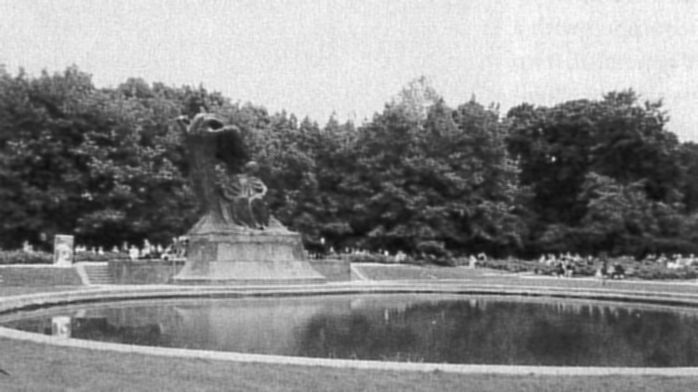 In summer, Chopin is played in the City Rose Garden every Sunday.
In summer, Chopin is played in the City Rose Garden every Sunday.
George Wipf presented beautiful dynamic simulations of the partitioning of complex ionophores between water and chloroform that showed good correlation with observed patterns in ion transportation and selectivity. George Gokel (USA) presented biological data suggesting that his covalenty linked cyclodextrins function as Ca+2 channels despite what appears to be insufficient length and amphiphilicity to permit membrane spanning and charge shielding presumed to be required for function. He has data that he feels rules out shuttle mechanisms, oligomerization or detergent effect with respect to his ion transporters. Careful study of patterns in self assembly and molecular recognition have raised question about subtle interactions including unconventional hydrogen bonds involving conjugated systems and covalently bound halogens. Ingeborg Csoregh (Sweden) presented evidence that, unexpectedly, CH...Cl interactions play a greater role in molecular self assembly than Cl...Cl interactions.
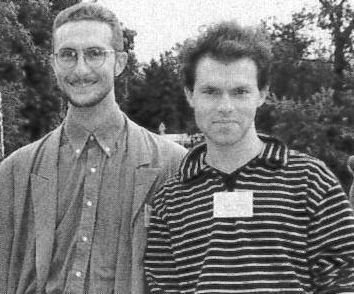 Ivan Huc and Daniel Funeriu, two bright young stars from the Lehn Lab attended the Sunday Chopin concert in the park. The cover illustration for this issue was provided by Funeriu, who was responsible for the X-ray analysis of the remarkable self assembling molecule.
Ivan Huc and Daniel Funeriu, two bright young stars from the Lehn Lab attended the Sunday Chopin concert in the park. The cover illustration for this issue was provided by Funeriu, who was responsible for the X-ray analysis of the remarkable self assembling molecule.
Extensive studies of bile acids (Mikiji Miyota, Japan) reveal interesting patterns in clathrate assembly associated with the chirality of four possible isomers of 3,7 dihydroxycholamide. Two isomers form complexes, two do not and four distinctly different crystal packing patterns are established. Tom Mak (Hong Kong) described the elaborate patterns arising from self association of the deceptively simple urea molecule. The complexes of the urea system seems to encompass classical inclusion compounds in which the urea molecules make up the host lattice at one extreme and supramolecular assemblys containing one or more urea molecules that are the nucleating guests in other crystal formations. If urea molecules are the host in some structures and guests in others, the many X-ray structures available may provide the data to clearly differentiate between these two phenomena.
Franz Schmidtchen (Munchen) reported that kinetics and entropy are more important than complementary fit in producing complex formation. This is in apparent conflict with the high degree of molecular complementarity seen in hundreds of crystal structures. Roger Bishop (Australia) created a family of structures with parallel channels running through them simultaneously designing supramolecule assemblies and the crystal systems they inhabit.
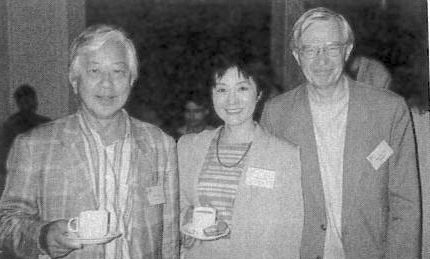 Toda, Kuroda and Lehn self assembling at the coffee break.
Toda, Kuroda and Lehn self assembling at the coffee break.
Reiko Kuroda (Japan) gave an elegant report on a system that seems to produce new isoforms as fast as she can determine their crystal structures. She is exploring details of how achiral molecules can induce chirality. She has found three different crystal forms of one racemic mixture. The second form rearranges into the third form upon exposure to a vapor of a pure enantiomer of the molecules. The polymorphs differ in the torsion angles of three phenyl substituents. Ashwini Nangra (India) described the relationship between chirality and ordered behavior in host-guest complexes. A symmetric guest will often be disordered in an asymmetric host site while an a symmetric guest will be ordered in the same environment. He described how an asymmetric host induces asymmetry in a symmetric guest.
Andre Colbert (France) discussed the 100 year history of attempts to distinguish the absolute configurations of the two possible enantiomers of the simplest chiral molecule, CHClBrF. There is evidence that the ratio of enantiomers in the naturally occuring racemic mixture differs by a few parts in 104. Attempts to measure this ratio have been undertaken on the belief that this will help establish how much time has elapsed since the big bang.
David Reinhoudt (The Netherlands) had to put a second floor on his apartment house when only midget molecules could fit on the first floor.
Thomas James (USA) described the 3D structure of the prion protein based upon the NMR data. Prion is a normal protein found in the brain. Accumulation of an aggregated form of the protein is the underlying cause of mad cow disease. The aggregated prion protein seems to be chemically identical to normal prion. The only apparent difference is conformational. James described intriguing examples of the influence of sequences upon the transformation of prion from its benign to its deadly form. Normal prion has an asparagine residue at position 178 and has isoforms with methionine (M) or valine (V) at position 129. When asparagine 178 is replaced with an aspartate it produces familial fatal insomnia in people having M(129) and Creutzfeldt-Jakob disease in people having V(129). The NMR structures reveal potential interactions on a loop structure that brings residues 129 and 178 close to one another.
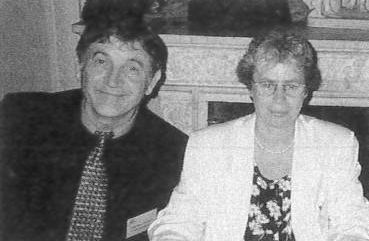 Nassimbeni and Csöregh sample soup at sumptuous symposium sit-down smörgåsbord soirée at Gablonna Palace.
Nassimbeni and Csöregh sample soup at sumptuous symposium sit-down smörgåsbord soirée at Gablonna Palace.
Although the potential for using supramolecular systems for nanoscale assay, chemical purification, processing, signalling and information management is proclaimed by all, the generation of these beautiful and complex structures is running well ahead of applications. Those at the forefront of practical application include Gerald Bradshaw (USA), Hans-Jörg Schneider (Germany), Torsten Strunz (Switzerland), Ronald Breslow (USA), Anthony Coleman (France) and Peter Dervan (USA).
Bradshaw gave one of the most practical talks of the meeting. He has designed and synthesized a family of molecules with high specificity and selectivity for monovalent and divalent ions. He is using a battery of complexing agents to purify the water in an old copper mine and separate the ions for reclamation. His recovery of palladium, chromium, bismuth, and mercury demonstrated creative and profitable use of ion complexing agents.
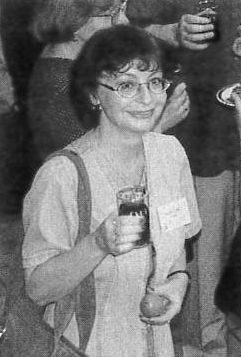 Kinga: Behind every successful crystallographic conference there is a tireless, talented and resourceful woman.
Kinga: Behind every successful crystallographic conference there is a tireless, talented and resourceful woman.
Schneider presented examples of molecule switches in which an ion triggers a conformational change that leads to molecular association that produces a fluorescent signal. Strunz placed an antibody in the sensing tip of an atomic force microscope and has created a very specific molecular sensing device. Breslow and Coleman have designed functional enzyme mimics.
Using novel chemical building blocks, Dervan is rewriting the genetic code in an effort to combat HIV. He discussed polynucleotide specificity of small hairpin polyamines in the major groove of B-DNA with remarkable potential for medicinal applications.
W.L. Duax


